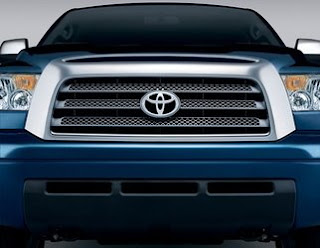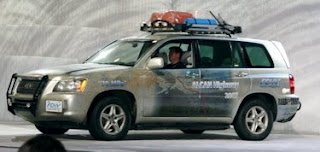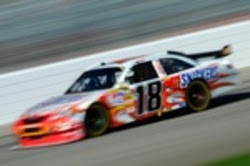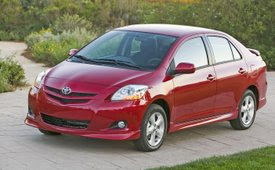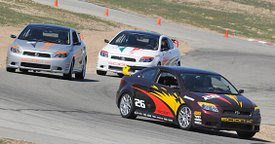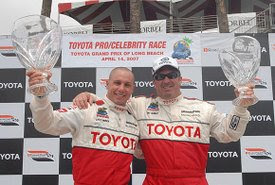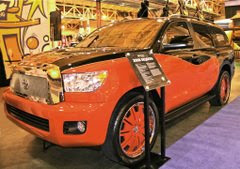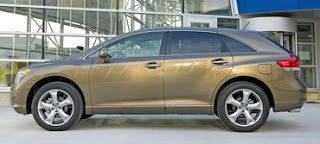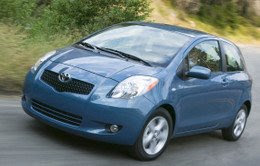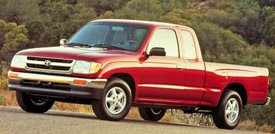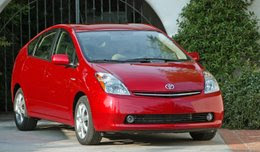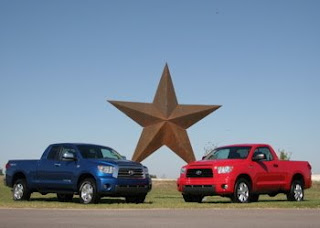
We’re pretty sure that most of you know by now that Toyota has built a new factory just outside San Antonio in which to assemble the Tundra half-ton pickup.
But what you may not know is just how interesting this factory is. So check this out:
This new plant is built on the 2,000-acre site of the former Walsh-Small Ranch, said to be the oldest cattle ranch in Texas, one that was active even before Texas statehood in 1845.
The new plant, called Toyota Motor Manufacturing, Texas, Inc., or TMMTX, was built to create up to 150,000 new Tundras each year with its crew of 2,000 team members. It augments an existing plant in Indiana, in operation since 1999, which also assembles Tundras.
San Antonio was chosen because the area around the city has plenty of flat, open ground, and because it also has a confluence of transportation facilities – both rail and highway. We need to be able to transport in raw materials, as well as transport out the finished Tundras.
But why Texas in the first place? That’s an easy one. Texas was chosen because it’s the capital of pickup sales in the United States – in fact, roughly one of every seven pickups sold in the U.S. is sold in Texas.
And also because San Antonio, the eighth largest city in the U.S., was seen as a repository of qualified workers. Indeed, http://www.fivestartoyota.com/ received more than 100,000 applications for the plant’s 2,000 jobs.
Toyota acquired the property in 2003 and broke ground in October of that year, moving 6.5 million cubic yards of dirt, pouring 250,000 yards of concrete (enough to pave a two-lane highway 53 miles long), erecting 15,000 tons of steel and installing 10 acres of siding.
At a total cost of $1.28 billion, the result is 2.2 million square feet, or 46 acres, of main factory built to create the Tundra at a rate of about 750 per day, starting from coils of steel rolling into one end of the building and ending with gleaming trucks rolling out the other.
In the stamping, welding and painting areas of the plant, about 400 robots do about 90 percent of the work, with the rest done by humans.
Humans also do most of the vehicle assembly – today’s robots are smart, but not smart enough to be certain that parts and components fit together properly.
Using this creative combination of brain power, muscle and machine, it takes about 24 hours to complete a truck – that’s going from raw steel to finished, painted, rolling and running state-of-the-art pickup.
Each truck comes down the line as a bare chassis, after the frame has been manufactured and its suspension, tires and wheels attached, and has a manifest, a sheet of paper, hanging from it, that shows what type of parts the truck needs. It’s kind of a recipe for what the truck will be.
This requires a very sophisticated parts-delivery system to make sure the right parts get to the line to match the vehicles. So in a process called “sequential build,” the seat-building company, for instance, completes its seats in exactly the right order, and it delivers those seats in exactly that order. The finished seats are loaded onto the assembly line in the proper order and installed in the truck they were meant for.
Our 21 on-site suppliers who provide parts, components and accessories are on-site, and they work in exactly this same way. They work in an additional 1.8 million square feet constructed to house their operations and the additional 2,100 workers who will be employed by them.
Tundra engines are produced in a Toyota Motor Manufacturing plant in Huntsville, Alabama, and transmissions are produced by a supplier in North Carolina. All are shipped to the Texas and Indiana facilities and installed there.
While some parts from Japan are being used on the new Tundra, 75% percent of the truck’s content is domestic.
As proud as Toyota is of this new state-of-the-art facility, it’s equally proud of the fact that the plant is a model citizen in environmental terms.
For instance, because much of the environmental impact in an automobile manufacturing facility comes from the painting operation, the Texas plant uses a water-borne paint system, with a water-borne primer. Without a solvent-based paint, emissions are much lower than they otherwise would be.
Water is an important consideration in an arid region such as this area of Texas, where most of the water supply comes from the area’s aquifers. The plant is built to minimize water use by utilizing recycled water in its processes.
The San Antonio plant operates as what’s called a zero-landfill facility. What this means is that no waste is being taken to a landfill. Instead, the plant will recycle extensively. For instance, scrap steel will return to the steel mill, scrap plastic will be shredded and returned to plastic pellet manufacturer.
Even the pallets upon which parts are delivered are plastic, rather than wood. That’s because wood breaks up and wears out, then must be disposed of in a landfill. Plastic can be used again and again.
The result, then, is not only a factory to match the Tundra, but a factory to match the economic and environmental needs of Texas, and of San Antonio. It’s a great way to go about assembling a vehicle. Especially when it is headed to http://www.fivestartoyota.com/
But what you may not know is just how interesting this factory is. So check this out:
This new plant is built on the 2,000-acre site of the former Walsh-Small Ranch, said to be the oldest cattle ranch in Texas, one that was active even before Texas statehood in 1845.
The new plant, called Toyota Motor Manufacturing, Texas, Inc., or TMMTX, was built to create up to 150,000 new Tundras each year with its crew of 2,000 team members. It augments an existing plant in Indiana, in operation since 1999, which also assembles Tundras.
San Antonio was chosen because the area around the city has plenty of flat, open ground, and because it also has a confluence of transportation facilities – both rail and highway. We need to be able to transport in raw materials, as well as transport out the finished Tundras.
But why Texas in the first place? That’s an easy one. Texas was chosen because it’s the capital of pickup sales in the United States – in fact, roughly one of every seven pickups sold in the U.S. is sold in Texas.
And also because San Antonio, the eighth largest city in the U.S., was seen as a repository of qualified workers. Indeed, http://www.fivestartoyota.com/ received more than 100,000 applications for the plant’s 2,000 jobs.
Toyota acquired the property in 2003 and broke ground in October of that year, moving 6.5 million cubic yards of dirt, pouring 250,000 yards of concrete (enough to pave a two-lane highway 53 miles long), erecting 15,000 tons of steel and installing 10 acres of siding.
At a total cost of $1.28 billion, the result is 2.2 million square feet, or 46 acres, of main factory built to create the Tundra at a rate of about 750 per day, starting from coils of steel rolling into one end of the building and ending with gleaming trucks rolling out the other.
In the stamping, welding and painting areas of the plant, about 400 robots do about 90 percent of the work, with the rest done by humans.
Humans also do most of the vehicle assembly – today’s robots are smart, but not smart enough to be certain that parts and components fit together properly.
Using this creative combination of brain power, muscle and machine, it takes about 24 hours to complete a truck – that’s going from raw steel to finished, painted, rolling and running state-of-the-art pickup.
Each truck comes down the line as a bare chassis, after the frame has been manufactured and its suspension, tires and wheels attached, and has a manifest, a sheet of paper, hanging from it, that shows what type of parts the truck needs. It’s kind of a recipe for what the truck will be.
This requires a very sophisticated parts-delivery system to make sure the right parts get to the line to match the vehicles. So in a process called “sequential build,” the seat-building company, for instance, completes its seats in exactly the right order, and it delivers those seats in exactly that order. The finished seats are loaded onto the assembly line in the proper order and installed in the truck they were meant for.
Our 21 on-site suppliers who provide parts, components and accessories are on-site, and they work in exactly this same way. They work in an additional 1.8 million square feet constructed to house their operations and the additional 2,100 workers who will be employed by them.
Tundra engines are produced in a Toyota Motor Manufacturing plant in Huntsville, Alabama, and transmissions are produced by a supplier in North Carolina. All are shipped to the Texas and Indiana facilities and installed there.
While some parts from Japan are being used on the new Tundra, 75% percent of the truck’s content is domestic.
As proud as Toyota is of this new state-of-the-art facility, it’s equally proud of the fact that the plant is a model citizen in environmental terms.
For instance, because much of the environmental impact in an automobile manufacturing facility comes from the painting operation, the Texas plant uses a water-borne paint system, with a water-borne primer. Without a solvent-based paint, emissions are much lower than they otherwise would be.
Water is an important consideration in an arid region such as this area of Texas, where most of the water supply comes from the area’s aquifers. The plant is built to minimize water use by utilizing recycled water in its processes.
The San Antonio plant operates as what’s called a zero-landfill facility. What this means is that no waste is being taken to a landfill. Instead, the plant will recycle extensively. For instance, scrap steel will return to the steel mill, scrap plastic will be shredded and returned to plastic pellet manufacturer.
Even the pallets upon which parts are delivered are plastic, rather than wood. That’s because wood breaks up and wears out, then must be disposed of in a landfill. Plastic can be used again and again.
The result, then, is not only a factory to match the Tundra, but a factory to match the economic and environmental needs of Texas, and of San Antonio. It’s a great way to go about assembling a vehicle. Especially when it is headed to http://www.fivestartoyota.com/
